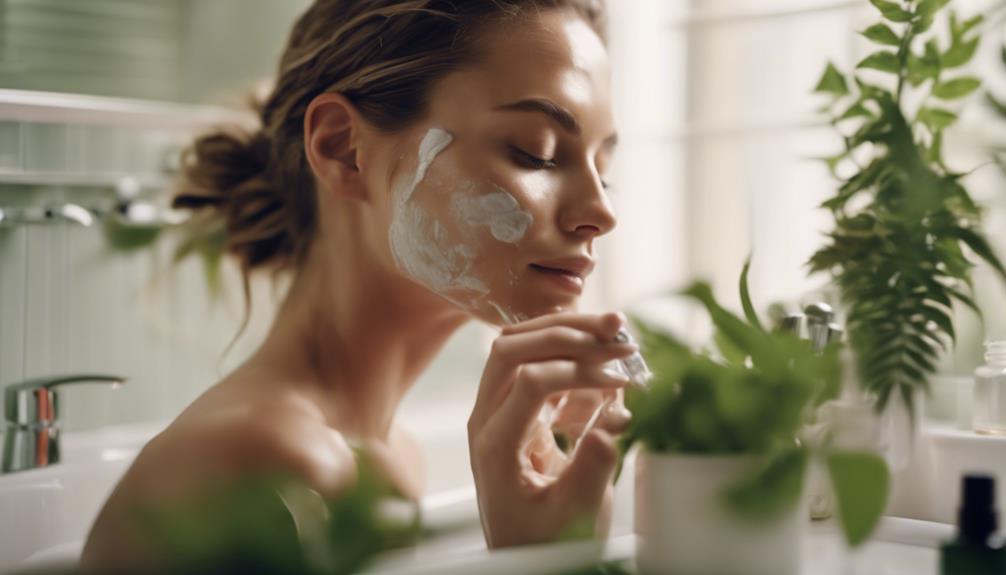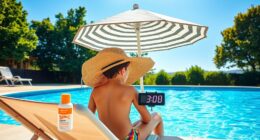Tanning weakens your skin’s natural barrier by damaging its outer layer, the stratum corneum, and depleting its repair resources. UV rays harm skin cells, causing premature aging and making your skin more vulnerable to environmental insults, moisture loss, and pollutants. Over time, repeated tanning exhausts your skin’s ability to recover, leaving it less resilient and more prone to dryness, redness, and sensitivity. Keep going to learn how to protect and strengthen your skin against further damage.
Key Takeaways
- Tanning damages the outermost skin layer, the stratum corneum, weakening its ability to retain moisture and protect against environmental insults.
- UV exposure increases melanin production, which exhausts skin’s repair resources and hampers barrier restoration.
- Repeated tanning accelerates the cycle of skin damage and repair, gradually diminishing skin resilience over time.
- UV rays cause lipid damage in skin cells, disrupting barrier integrity and increasing vulnerability to dryness and irritation.
- A weakened skin barrier from tanning reduces the skin’s capacity to defend against pollutants, bacteria, and UV damage, accelerating aging.

Have you ever wondered how your skin protects itself from the sun’s harmful ultraviolet (UV) rays? Your skin acts as a formidable barrier, defending you against UV damage that can cause more than just a tan. When UV rays penetrate your skin, they can damage the cells, DNA, and other structures, leading to issues like premature aging and increased cancer risk. But your skin isn’t just passive; it actively responds by triggering skin repair processes, trying to fix the damage caused by UV exposure. However, this constant battle wears down your skin’s defenses over time, especially when you indulge in tanning, whether outdoors or in tanning beds.
Your skin’s barrier protects against UV damage but weakens with excessive tanning.
Tanning might seem like a quick way to get a golden glow, but it actually weakens your skin’s barrier. When you expose your skin to UV rays, you initiate a chain of reactions that compromise its integrity. UV damage harms the outermost layer, the stratum corneum, which is essential for keeping moisture in and harmful elements out. As your skin attempts to repair itself, it produces new cells and increases production of melanin, which gives you that tanned appearance. Unfortunately, this process is not without consequence. Repeated UV exposure hampers your skin’s ability to repair itself effectively because it exhausts the resources needed for skin renewal, leading to a weakened barrier over time.
This weakened barrier makes your skin more vulnerable to environmental insults, moisture loss, and future UV damage. When the skin barrier is compromised, it can’t defend against irritants, bacteria, or pollutants, creating a cycle of damage and repair that leaves your skin less resilient. Tanning accelerates this cycle, as the UV rays not only damage the DNA but also impair the skin’s natural ability to repair itself. The more you tan, the more you push your skin’s repair mechanisms to their limits, gradually diminishing its capacity to recover from UV damage efficiently.
As your skin’s barrier weakens, it becomes more prone to dryness, redness, and sensitivity. Over time, the damage accumulates, making it harder for your skin to bounce back. This is why consistent tanning can lead to premature aging signs like wrinkles and leathery skin. Protecting your skin from UV damage means allowing your natural skin repair processes to work *effectively*. Using broad-spectrum sunscreens, avoiding excessive sun exposure, and adopting skincare routines that strengthen your skin barrier are essential steps. Remember, every time you tan, you’re not just changing your appearance temporarily—you’re weakening your skin’s ability to repair itself and defend against future UV damage, leaving you more vulnerable over the long run.
Additionally, UV rays can also damage the lipids within the skin, further disrupting the barrier and making it even more difficult for your skin to retain moisture and stay resilient and repair itself.
Frequently Asked Questions
Can Indoor Tanning Damage the Skin Barrier Like Sun Exposure?
Indoor tanning can damage your skin barrier just like sun exposure. When you tan indoors, the UV rays penetrate your skin, disrupting its natural barrier integrity. This weakens your skin’s ability to protect against environmental toxins and moisture loss. Over time, indoor tanning increases the risk of irritation, dryness, and premature aging. Protect your skin by avoiding indoor tanning and using broad-spectrum SPF daily to maintain your skin’s health and barrier strength.
How Long Does It Take to Repair UV Damage to the Skin Barrier?
It usually takes about 2 to 4 weeks for your skin to recover and repair the barrier after UV damage. During this time, you should focus on skin recovery by moisturizing regularly, avoiding further sun exposure, and using gentle skincare products. Consistent barrier repair helps restore your skin’s natural defenses, but patience is key. Protecting your skin now prevents future damage and supports faster healing.
Are There Specific Ingredients That Help Strengthen the Skin Barrier After UV Damage?
Yes, certain ingredients like ceramides, niacinamide, and fatty acids help strengthen your skin barrier after UV damage. They improve ingredient benefits by restoring lipids and enhancing repair. Incorporate recovery strategies with these ingredients into your skincare routine to support healing. Using barrier-repair creams or serums containing these components can accelerate your skin’s recovery, making it more resilient against future UV exposure.
Does UV Exposure Affect Skin Barrier Function Differently in Different Skin Types?
Imagine your skin as a fortress; UV exposure tests its strength differently based on your genetic differences. If you have more melanin, your natural protection acts like a shield, reducing damage to your skin barrier. Conversely, lighter skin offers less defense, making it more vulnerable. So, yes, UV affects your skin barrier function uniquely, depending on your skin type and melanin levels, influencing how well your skin stays resilient after sun exposure.
Can Sunscreen Fully Prevent the Weakening of the Skin Barrier From UV Rays?
Sunscreen can’t fully prevent the weakening of your skin barrier from UV rays, but its efficacy markedly reduces damage. Proper barrier protection depends on broad-spectrum sunscreens with adequate SPF, applied generously and regularly. While sunscreen helps shield your skin, it’s essential to combine it with other protective measures like seeking shade and wearing protective clothing, ensuring you get the best defense against UV-induced barrier damage.
Conclusion
Remember, every time you tan, you’re throwing a tiny grenade at your skin’s barrier, making it weaker than ever. UV rays don’t just tan your skin—they attack your barrier, leaving it vulnerable and crying out for help. Protecting your skin isn’t just about looking good today; it’s about saving it from a future that’s far more brutal. So, shield up, stay smart, and keep your skin’s fortress strong—because no glow is worth a ruined barrier.









